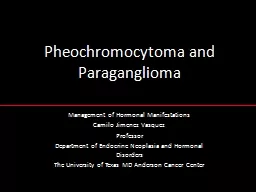

Management of Hormonal Manifestations Camilo Jimenez Vasquez Professor Department of Endocrine Neoplasia and Hormonal Disorders The University of Texas MD Anderson Cancer Center Outline Introduction ID: 908553
Download Presentation The PPT/PDF document "Pheochromocytoma and Paraganglioma" is the property of its rightful owner. Permission is granted to download and print the materials on this web site for personal, non-commercial use only, and to display it on your personal computer provided you do not modify the materials and that you retain all copyright notices contained in the materials. By downloading content from our website, you accept the terms of this agreement.
Slide1
Pheochromocytoma and Paraganglioma
Management of Hormonal ManifestationsCamilo Jimenez VasquezProfessorDepartment of Endocrine Neoplasia and Hormonal Disorders The University of Texas MD Anderson Cancer Center
Slide2Outline
IntroductionAnatomical definitionsClinical manifestationsTreatmentHypertension and prevention of cardiovascular complicationsGastrointestinal disease
Slide3Paraganglia
Group of neuro-endocrine cells that migrate during embryonic development with components of the parasympathetic and sympathetic ganglia.
Slide4Catecholamines are the hormones of stress
They are the hormones we use to escape and/or fight
Slide5Pheochromocytomas
Chromaffin (+) tumors originated in the adrenal medulla. They may produce catecholamines such as epinephrine and/or norepinephrine predisposing to cardiovascular disease and other complications.
WHO 2017
Slide6Slide7Paragangliomas
Paragangliomas are tumors that arise from extra-adrenal
chromaffin
cells and can originate either in the parasympathetic or sympathetic ganglia.
Parasympathetic
:
chemodectomas
, carotid body tumors,
glomus
jugular tumors, etc.
Sympathetic
: thoracic, abdominal, and pelvic tumors. They may produce norepinephrine
and/or dopamine predisposing to cardiovascular disease and other endocrine complications
WHO 2017
Slide8Slide9Clinical manifestations
Symptom
Frequency %
Headaches
60-90
Palpitations
50-70
Diaphoresis
55-75
Pallor
40-45
Nausea
20-40
Weight loss
10-20
Flushing
20-40
Fatigue
20-40
Anxiety – Panic attacks
25-40
Sustained
hypertension
50-60
Paroxysmal hypertension
30
Orthostatic hypotension10-50
Lenders, Lancet 2005
Slide10Prevention of complications
Slide11Back pain
Throbbing
hedaches
Diaphoresis
Palpitations
Blood pressure 137/65
Normetanephrines = 2300 NG/ML (<400)
Metanephrines are normal
Von Hippel Lindau
Rich, Cancer Investigation, 2008
Slide12Surgery may provoke a release of catecholamines
Drugs/Procedure
Details
Procedure
Mechanic intubation, peritoneal
insufflation
, tumor palpation
Opiates
Thiopental, nalbufine, meperidine, morphine
Neuromuscular Blockers
Tubocurare, succinilcoline, mevacurio, atracurio
Tranquilizers and antiemetics
Metoclopramide, droperidol
Simpaticomimetics
Efedrine
Vagolitics
Atropine
Slide13Organ
Receptor
Physiological
Effect
Symptom
Arterioles
Coronary
Alpha-1
Contraction
Angina
Skin and mucosa
Alpha-1
Contraction
Pallor
Skeletal
muscle
Alpha-1, Beta-2
Contraction,
dilation
Cerebral
Alpha-1
Contraction
Stroke
Pulmonary
Alpha-1
Contraction
Pulmonary edema
Abdominal VisceraAlpha-1
Contraction
Intestinal ischemiaRenalAlpha-1
Contraction
Renal
failure
Veins
Alpha-1, Beta-2
Contraction
dilation
Orthostatism
Heart
SA node
Beta-1
⌂ Inotropism
Angina, arrhythmias
Atrium
Beta-1
⌂ InotropismAngina, arrhythmiasAV nodeBeta-1⌂ InotropismAngina, arrhythmiasHis-PurkinjeBeta-1⌂ InotropismAngina, arrhythmiasVentricleBeta-1⌂ InotropismAngina, arrhythmias
Slide14Impact of alpha-blockage on surgical outcome
Goldstein, Annals of Surgery, 1999
Slide15How to choose the alpha-blocker?
Slide16Alpha-blocker
Type
Dosage
Half-life
Side effects
Availability/
Monthly
Price
Phenoxybenzamine
Non-selective,
non-c
ompetitive
10 – 140 mg/daily
10 days
POP persistent
Hypotension,
reflex tachycardia, nasal congestion
Edema
Difficult to get in many countries
US 61.00- 1500
Prazosin
Alpha-1 competitive
1-16 mg/daily
3- hours
Orthostatism,
tachycardiaEasy to find/ US 13.00TerazosinAlpha-1Competitive1-48 mg daily24 hoursOrthostatism, tachycardiaEasy to find/US 4.00DoxazosinAlpha-1Competitive
1-48 mg daily24 hours
Orthostatism, tachycardia
Easy to find/US 20.00
Slide17Beta-blockers
They should be initiated once the patient develops orthostatism and/or reflex tachycardia which indicate that alpha blockage has been obtained.Selective: Metoprolol, AtenololNon-selective: PropranololLabetalol and Carvedilol
Slide18Calcium Channel Blockers, ACE inhibitors, Angiotensin Receptor Blockers
Indications:Mild cases (e.g. small tumors identified by radiographic screening in patient with hereditary predisposition) or unable to tolerate alpha-blockersAs a supplement to alpha- and beta-blockers when BP is still difficult to controlAs a supplement to alpha- and beta-blockers in order to prevent toxicity associated with higher doses
Slide19Metyrosine
Tyrosine hydroxylase inhibitorIt decreases catecholamine secretionIt has side effects that frequently prevent the use of effective doses: fatigue, depression, anxiety, diarrheaPrice > US 1000
Slide20How long it takes to prepare someone for surgery?
7-14 daysAt MDACC the average time is 8 days thanks to communication with the patient daily and frequent drug adjustmentsThere is no need to admit the patient to the hospital or to use metyrosine.The patient should have a normal salt diet and free water intake. IV fluids may be necessary before surgery.
Slide21Gastrointestinal complications
Slide22Case
46 year-old man with a metastatic paraganglioma complains of hypertension, palpitations, headaches, sweats, and constipation. Constipation has been present for longer than one year. Last bowel movement was hard and occurred one week ago. The patient lacks of appetite. He complains of nausea and fever. Creatinine and WBC are elevatedPlasma normetanephrines: 49.5 nmol/L (<0.90)
Thosani
, EJE, 2015
Slide23Case
Thosani
, EJE, 2015
Slide24Severity of constipation
Grade 1: Occasional or intermittent symptomsGrade 2: Persistent. It requires laxatives and impairs regular activities (driving, seating)Grade 3: Manual evacuation is requiredGrade 4: life-threateningGrade 5: Death
Slide25Constipation
6% of patients with pheochromocytoma and paraganglioma have it.It is usually mild; occasionally, it is severeIt predisposes to hemorrhoids, stercoral ulcers, bleeding, perforation, obstruction, malnourishment, and toxic megacolon.Alpha- and beta-blockers do not treat constipationIt is preventable with a diet rich in fiber and liquids
Thosani
, EJE, 2015
Slide26Treatment
Grade 1 and 2Diet with fiber, liquids, and warm beveragesStimulant laxatives (docusate) and stool softeners (senna); Add milk of magnesia and/or mineral oil if the previous measures do not workGrade 3 and 4Mineral oil, magnesium citrate, milk and molasses enemas. Do not use normal saline enemas.
Polyethylene glycol
Hydration with normal saline
Thosani
, EJE, 2015
Slide27Treatment
Thosani
, EJE, 2015
Slide28Patients’ tasks
To check blood pressure and pulse periodicallyGoal: to keep blood pressure always normalTo follow a diet rich in fiber, warm beverages, good hydration, and normal salt contentGoal: to prevent constipation and keep hydration
Slide29Conclusions
Patients with pheochromocytomas and pargangliomas are prone to develop endocrine complicationsEndocrine complications are preventable and treatableExpertise and common sense are very important to treat these patients
Slide30cjimenez@mdanderson.org
Slide31Most serious problems
Organ
Complication
Heart
Arrhythmias,
heart attacks, angina, hear failure
Lungs
Pulmonary edema
Kidneys
Renal
failure
Eyes
Retinopathy
Intestines
Ischemia, constipation
Brain
Strokes